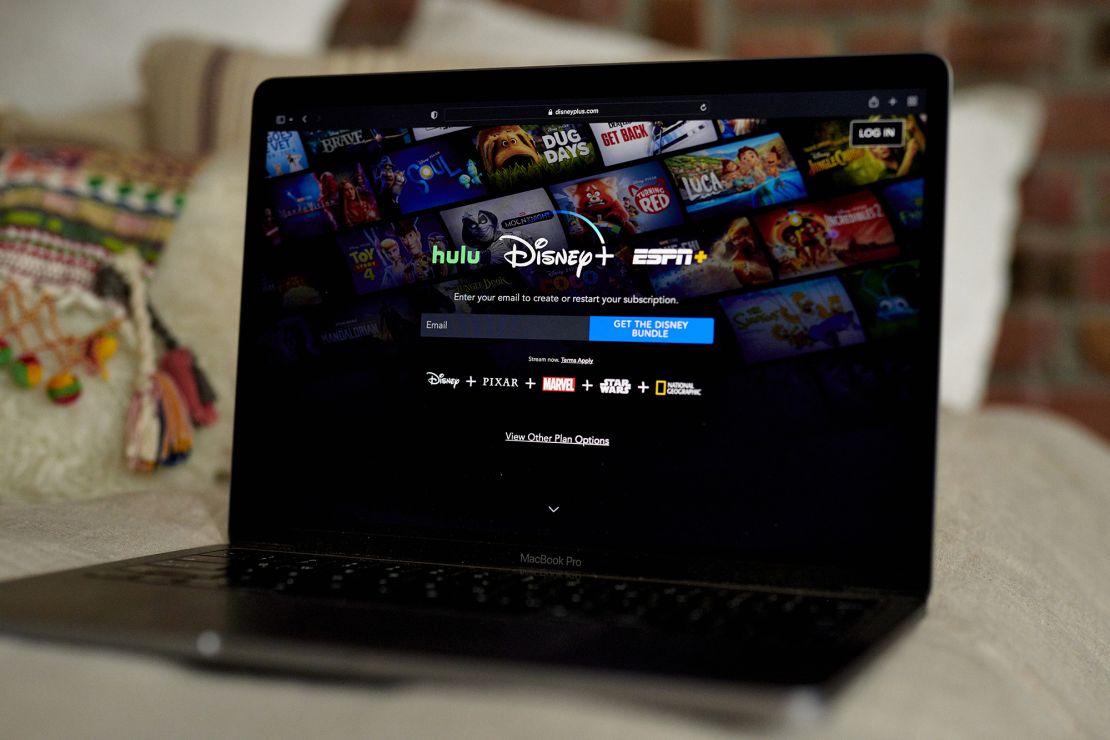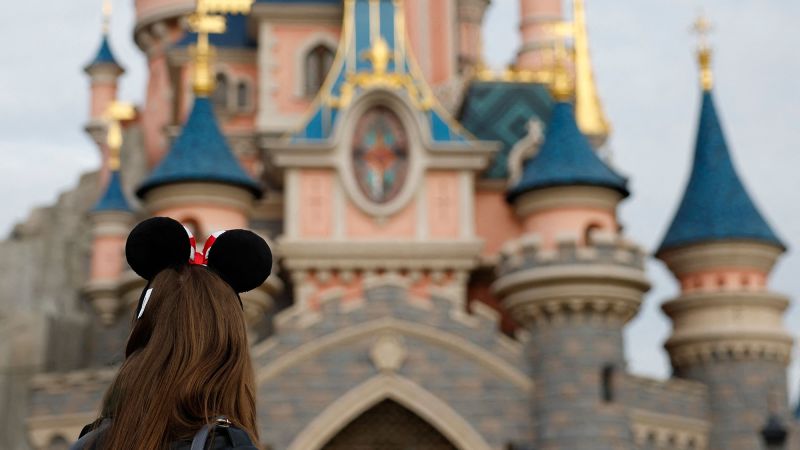The magic has been missing this year for Disney.
Last month, the company celebrated its 100th anniversary – and there was much to commemorate. Over the last century, the company has grown into one of the largest publicly traded media and entertainment companies in the world, with a market cap of more than $150 billion.
But the future of the House of Mouse hangs in the balance as the company contends with a still-unprofitable streaming business, an ongoing actors strike, declining attendance at Disney World Resort in central Florida, legal battles with Republican presidential candidate Florida Gov. Ron DeSantis, and uncertainty surrounding a CEO succession plan.
Disney’s stock, at about $84 per share, is at its lowest level in nearly ten years. It is down 8% since CEO Bob Iger returned as CEO last November, and it’s down 3% since the start of the year. Compare that to some of Disney’s rivals: Comcast’s stock is up more than 18% this year, and Warner Bros. Discovery, which owns CNN, is up 22%.
Like its competitors, Disney faces an uncertain media environment as viewers increasingly tune out linear TV in favor of entertainment sources Big Media doesn’t control, including TikTok and YouTube. But Disney has been hit particularly hard by some big misses at the box office and questions about how it will replace its fading cash cow, ESPN, among other issues.
The company reported its quarterly earnings on Wednesday afternoon and slightly missed expectations on sales but reported better-than-expected earnings. The company added 7 million core Disney+ subscribers and narrowed its streaming losses. But Iger announced more severe cost cuts at the company.
On Monday, Disney announced that Hugh Johnston, the chief financial officer at PepsiCo, would take over as Disney’s CFO, filling the role vacated by longtime Disney executive Christine McCarthy in May. Disney, which is in a quiet period in the lead-up to its earnings announcement, did not respond to a request for comment.
It’s no secret that the linear TV business is struggling, and Disney’s problems with traditional TV also affect nearly all other US legacy media companies.
Last quarter, Disney’s linear television revenue continued to slip, declining 7% compared to the same quarter last year.
But Iger has hinted at a plan to generate cash for Disney’s linear assets, which include ABC, Disney Channel, FX and National Geographic, through a potential sale.
“While linear remains highly profitable for Disney today, the trends being fueled by cord-cutting are unmistakable,” Iger said in August. “As I’ve stated before, we’re thinking expansively and considering a variety of strategic options.”
ESPN remains a bright spot in Disney’s traditional media portfolio, continuing to attract sports fans to cable TV. In a recent note to clients, Bank of America’s Jessica Reif Ehrlich called ESPN “the glue enabling the cable bundle to maintain its profitability.”
But viewership is down as cord cutting grows. That’s why Ehrlich also said ESPN should accelerate its transition to streaming as fewer people pay for traditional TV and sports licensing costs continue to go up.
Disney’s plan to transition its business to a new age of streaming has had uneven results.
In October, Disney hiked the price of its ad-free Disney+ subscription to $13.99 per month while keeping the price of its advertising tier steady at $7.99 per month.
“The advertising marketplace for streaming is picking up. It’s more healthy than the advertising marketplace for linear television,” Iger said in August on Disney’s third quarter earnings call.
The price hike comes as Disney’s streaming service continues to burn cash, though the company has indicated that it believes Disney+ will begin generating profits by the end of 2024.
One potential hiccup to Disney’s plan: Disney lost streaming subscribers in the US and Canada last quarter, though international signups grew by 2%.
Jason Bazinet, a media analyst at Citigroup, said investors will be watching closely this quarter to see if Disney’s recent streaming price hikes will result in even more subscription cancellations or if the pace of drop-offs slowed.
Though Disney may potentially have another plan to gin up revenue for the streaming service: Following in Netflix’s footsteps, Disney has hinted that it will expand a password-sharing crackdown on Disney+, which company executives could shed light on during Wednesday’s earnings call.

However, Disney isn’t staking its entire streaming future on Disney+.
Earlier this month, Disney announced it would acquire Comcast’s one-third stake in Hulu for $8.61 billion, meaning that Disney will now own 100% of the streaming service.
Changing consumer tastes may also pose a risk to Disney’s financial health. Several of Disney’s high-profile movie bets were a bust at the box office this year, including “Indiana Jones and the Dial of Destiny” and “Ant-Man and the Wasp: Quantumania.”
Evercore’s Disney analyst Vijay Jayant wrote in a note last week that he expects Disney to “modestly underperform” fourth-quarter estimates due to weaker linear advertising and Indiana Jones’ underperformance at the box office. The latest installment of Indiana Jones was released in the US on June 30.
Questions about Disney’s content slate come as Hollywood productions have largely been shut down for more than 6 months after writers went on strike from May until September, and an actors’ strike is ongoing.
It may not be all bad news for Disney, though.
Last quarter, the company’s parks division was a highlight, with revenue jumping 13% to $8.3 billion.
Disney said most of its growth was fueled by international parks like Shanghai Disney Resort and Hong Kong Disneyland Resort.
In September, Disney announced it would lean more heavily into its theme park business, doubling capital expenditures over the next 10 years to roughly $60 billion. The company plans to use that money to expand its domestic and international parks and cruise line capacity.
However, Disney World Resort in Florida has struggled with declining attendance in recent months. Over the summer, Disney World parkgoers experienced shorter-than-expected ride wait times and fewer crowds.
Iger has attributed the recent declines to an overall slump in Central Florida tourism, though Wednesday’s earnings will show how greatly the summer slowdown impacted park revenue since the financial results cover Disney’s fiscal fourth quarter, which began in July and ended in October of this year.
And an ongoing legal battle with Florida over control of the district that contains Disney World has led to an unwanted spotlight on the company’s politics and debate over its position in the culture wars.
The uncertainty faced by Disney comes at a time of upheaval at the company’s corporate offices.
Earlier this year, Iger announced that the media giant would axe roughly 7,000 employees from its global workforce in three waves.
Shakeups at the company have not precluded the C-suite, either. Nearly one year ago, Iger unexpectedly came out of retirement to take over the role of Disney CEO once again after the board unexpectedly fired his successor, Bob Chapek.
More recently, Disney’s longtime CFO, Christine McCarthy, left her position in June. This week, Johnston was announced as her replacement.
Iger has promised that in his second act as CEO, he is “intensely focused” on finding a viable CEO to take his place when his contract expires at the end of 2026, though it’s unclear whether the search for a new CEO has yielded any results so far.
Read the full article here










